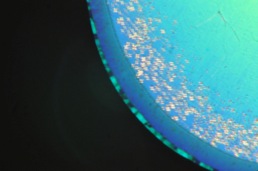Alexander Lorenz, featured ILCC liquid crystal artist, March 2012
Dr. Alexander Lorenz is an alumnus and postdoctoral fellow of the Research Training Group “Micro- and Nanostructures in Optoelectronics and Photonics” (DFG, GRK1464) at the University of Paderborn. In May 2010, he was awarded the Young Scientist Award of the German Liquid Crystal Society (DFKG, category: oral presentation). He finished his dissertation on ‘Switchable waveguiding in photonic liquid crystal microstructures’ in July 2010 in Heinz Kitzerow’s group. His current research interests are focused on X-ray studies of nanoparticle doped liquid crystals and electro-optic studies of doped nematic and chiral nematic liquid crystals (supported by the European Science Foundation EUROCORES, SONS II, ‘Self-organized nanostructures’).

In summary, the micrograph shows an isotropic region followed by two blue phases, which both are rather blue-colored, and finally, a phase transition to the cholesteric phase. The driving force behind this behavior is a decreasing concentration of the chiral dopant / a decrease of chirality.
In conclusion, this kind of micrograph shows that liquid crystals are one of Nature’s beautiful ways to draw a phase diagram.
Dimensions of the image: ≈ 360x240 µm.
Chiral nematic liquid crystal used: RO-TN-403/CB15 (70/30 %vol).
Jury comment: anisotropic moonlight


